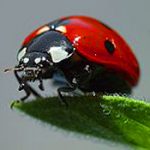Ladybugs are small insects, ranging from 1 mm to 10 mm (0.04 to 0.4 inches), and are commonly yellow, orange, or scarlet with small black spots on their wing covers, with black legs, head and antennae. A very large number of this species are mostly, or entirely, black, grey, or brown and may be difficult for non-entomologists to recognize as ladybugs.
A few species are considered pests in North America and Europe, but they are generally considered useful insects as many species feed on aphids or scale insects, which are pests in gardens, agricultural fields, orchards, and similar places. Harmonia axyridis (or the Harlequin ladybug) was introduced into North America from Asia in 1988 to control aphids but is now the most common species as it is out-competing many of the native species.
A common myth is that the number of spots on the insect’s back indicates its age.
Most ladybugs are beneficial to gardeners in general, as they feed on aphids, scale insects, mealybugs, and mites throughout the winter. As in many insects, ladybugs in temperate regions enter diapause during the winter, so they often are among the first insects to appear in the spring. Some species gather into groups and move to higher land, such as a mountain, to enter diapause. Predatory ladybugs are usually found on plants where aphids or scale insects are, and they lay their eggs near their prey, to increase the likelihood the larvae will find the prey easily. Ladybugs are cosmopolitan in distribution, as are their prey.
Ladybugs also require a source of pollen for food and are attracted to specific types of plants. The most popular ones are any type of mustard plant, as well as other early blooming nectar and pollen sources, like buckwheat, coriander, red or crimson clover, and legumes like vetches, and also early aphid sources, such as bronze fennel, dill, coriander, caraway, angelica, tansy, yarrow, of the wild carrot family, Apiaceae. Other plants that also attract ladybugs include coreopsis, cosmos (especially the white ones), dandelions and scented geraniums.
In the United States, ladybugs usually begin to appear indoors in the fall. They leave their summer feeding sites in fields, forests and yards looking for a place to spend the winter. Typically when temperatures warm to the mid-60s Fahrenheit in the late afternoon, following a period of cooler weather, they will swarm onto or into buildings illuminated by the sun. Swarms of ladybugs fly to buildings in September through November depending on location and weather conditions. Also, homes or buildings near fields or woods are more prone to infestation.

